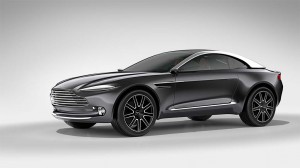Normally low-key Aston Martin generated some buzz going into this year’s Geneva Motor Show with the planned introduction of its new Vulcan race car. But as hordes of media descended on the British maker’s small stand it delivered a much bigger surprise. The DBX is not just the first crossover-utility vehicle Aston has ever come up with, but also the marque’s first all-electric vehicle.
Though the top secret project is, for the moment, officially being described as just a “concept,” a senior Aston executive made it clear to TheDetroitBureau.com that a production version is all but certain to follow. And it will be part of a grand remake of the company that will see a significant expansion of its current product portfolio in the coming years.
“We want to build it,” stressed Aston Martin marketing chief Simon Sproule,” though he cautioned that the DBX that would not reach showrooms until “the end of the decade.” And when it does, it likely will abandon the three-door coupe body style in favor of a slightly more utilitarian five-door design featuring two rows and five seats.
The project, it turns out, was not just the brainchild of new Aston CEO Andy Palmer, but also one of the first things he took on after joining the British company last October. Palmer commissioned the project just four days after reporting for work at the carmaker’s headquarters in Gaydon.
“I asked my team at Aston Martin to expand their thinking beyond conventions, to explore what the future of luxury GT motoring would look like in years ahead, and the DBX Concept you see before you is the result,” Palmer explained during the Aston Martin news conference at Geneva’s PALExpo convention center.
Considering how quickly the DBX concept came together it’s no surprise that a number of key details have yet to be worked out. Among the most critical, “We have not decided yet” what engine it will use, said Sproule, noting that Aston will have several options by the time the DBX would be ready to roll out. That includes an updated version of the company’s current V-12, as well as an all-new V-8 Aston will get through a new partnership with Daimler AG developed by its AMG subsidiary.
Daimler may also help provide the DBX’s all-wheel-drive system and other underlying components, said Aston’s new marketing chief who, like CEO Palmer came to the company from Nissan last year.
A third option is to go with an electric drive, whether hybrid or full battery power, something that Aston sees as critical to its long-term plans. Like other luxury makers, it faces the challenge of meeting tough new global mileage and emissions standards – as well as proposed mandates that might restrict access to major urban centers such as Paris to vehicles running on battery power.
In concept form, the DBX is powered by four individual electric motors, one on each wheel. That alternate approach to all-wheel-drive would have the advantage of being able to accomplish torque vectoring and other dynamic control without the awkward brake intervention systems found on most of today’s high-performance models.
As shown in Geneva, the DBX uses lithium-sulfur batteries designed to balance range and performance. The maker’s ability to charge quickly into the world of battery power was helped by the fact that Palmer previously was one of the key players in Nissan’s own electric vehicle program.
As with most Aston Martin vehicles, the DBX isn’t just another boxy ute. It clearly lifts its design DNA from other DB-badged models, albeit sitting far higher off the ground and getting some of the accoutrements one would expect of an off-roader.
(Aston Martin takes to track with new Vulcan. For more, Click Here.)
It also features some intriguing technologies, such as steer-by-wire, and “smart” window glass that can automatically dim. Both driver and passenger get heads-up displays, meanwhile.
Little more than a year ago, a vehicle like the DBX would have seemed an unlikely fantasy for a company that, at the time, was running short of cash to keep even its basic product programs going. But Aston not only recruited a new coterie of senior managers but also lined up critical new funding, including $500 million for product development.
(Click Here for details about the debut of the Aventador 750-4 Superveloce.)
Ultimately, it plans to have six or seven models in its line-up, noted Sproule, “so we’re (introducing) a new car every year.”
Meanwhile, they will fall into three distinct categories, he explained, starting with the classic Aston sports cars, such as the Vantage and DB9. Sales of those models, he noted, would be capped at around 7,000 annually.
A second product group would include sedans such as the reborn Lagonda. These would be much more sporty than comparable “saloon” models from the likes of Bentley or Rolls-Royce, Sproule suggested, “more Concorde than Airbus.”
(To see what Bentley’s future may look like, Click Here.)
The DBX would fall into a third category of crossovers.
The British maker will join an increasingly crowded field there, with new CUVs coming from Bentley, Rolls and Maserati, among others. But considering that utility vehicles are gaining ground in markets all over the world, from entry-level to ultra-lux, Aston is confident there will be more than enough room for it to join the fray with the DBX.

